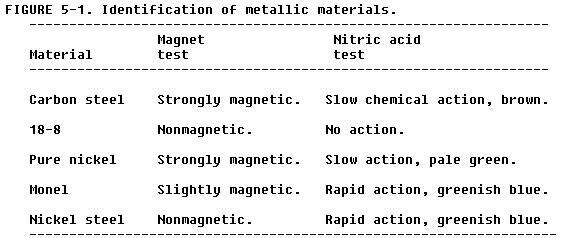
Before making repairs to any aircraft plumbing, it is important to make accurate identification of plumbing materials. Aluminum alloy or steel tubing can be identified readily by sight where it is used as the basic plumbing material. However, it is difficult to determine whether a material is carbon steel or stainless steel, or whether it is 1100, 3003, 5052-O, or 2024-T aluminum alloy.
It may be necessary to test samples of the material for hardness by filing or scratching with a scriber. The magnet test is the simplest method for distinguishing between the annealed austenitic and the ferritic stainless steels. The austenitic types are nonmagnetic unless heavily cold worked, whereas the straight chromium carbon and low alloy steels are strongly magnetic. Figure 5-1 gives the methods for identifying five common metallic materials by using the magnet and concentrated nitric acid tests.

By comparing code markings of the replacement tubing with the original markings on the tubing being replaced, it is possible to identify definitely the material used in the original installation.
The alloy designation is stamped on the surface of large aluminum alloy tubing. On small aluminum alloy tubing, the designation may be stamped on the surface, but more often it is shown by a color code. Bands of the color code, not more than 4 inches in width, are painted at the two ends and approximately midway between the ends of some tubing. When the band consists of two colors, one-half the width is used for each color.
Painted color codes used to identify aluminum alloy tubing are:

Aluminum alloy tubing, 1100 (1/2 hard) or 3003 (1/2 hard), is used for general purpose lines of low or negligible fluid pressures, such as instrument lines and ventilating conduits. The 2024-T and 5052-O aluminum alloy materials are used in general purpose systems of low and medium pressures, such as hydraulic and pneumatic 1,000 to 1,500 psi systems and fuel and oil lines. Occasionally, these materials are used in high pressure (3,000 psi) systems.
Tubing made from 2024-T and 5052-O materials will withstand a fairly high pressure before bursting. These materials are easily flared and are soft enough to be formed with handtools. They must be handled with care to prevent scratches, dents, and nicks.
Corrosion resistant steel tubing, either annealed or 1/4 hard, is used extensively in high pressure hydraulic systems for the operation of landing gear, flaps, brakes, and the like. External brake lines should always be made of corrosion resistant steel to minimize damage from rocks thrown by the tires during takeoff and landing, and from careless ground handling. Although identification markings for steel tubing differ, each usually includes the manufacturer's name or trademark, the SAE number, and the physical condition of the metal.
Metal tubing is sized by outside diameter, which is measured fractionally in sixteenths of an inch. Thus Number 6 tubing is 6/16 (or 3/8 inch) and Number 8 tubing is 8/16 (or 1/2 inch), etc.
In addition to other classification or means of identification, tubing is manufactured in various wall thicknesses. Thus, it is important when installing tubing to know not only the material and outside diameter, but also the thickness of the wall.